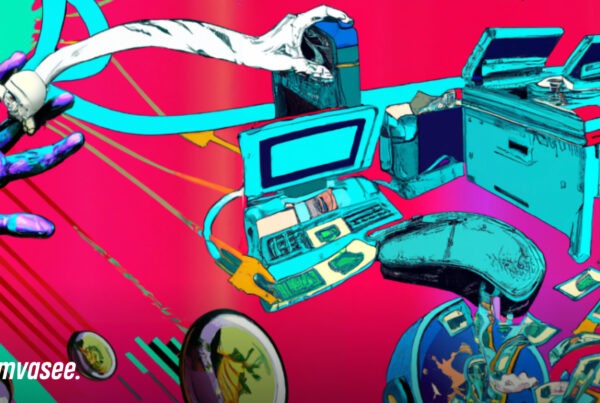
Welcome to this week’s newsletter. Today, we are going to be talking about how blockchain technology can be used in governments. What are the potential benefits and difficulties of using them?
But first, let me give you a brief overview of blockchain. When you hear the word blockchain, don’t immediately associate it with cryptocurrencies, NFTs, and the world’s scams and Sam Bankmans. Blockchain is used for more than just cryptocurrency. Blockchain is what allows cryptocurrencies to exist, but its capabilities extend far beyond that. So, what exactly is blockchain? Blockchain is a distributed, immutable ledger that makes it easier to record transactions and track assets in a network. An asset can be physical (a house, car, money, or piece of land) or intangible (intellectual property, patents, copyrights, branding, cryptocurrencies and NFTs). A blockchain network can track and trade almost anything of value.
Today, we are focusing on blockchain in government. We are all aware that governments can be inefficient, opaque, and corrupt at times. However, Blockchain technology has the potential to transform the way governments operate, providing a new level of transparency and accountability. It can assist governments in increasing the efficiency and effectiveness of their processes by allowing the creation of difficult-to-alter digital records and the use of smart contracts. In this article, we will look at how blockchain technology can be used to improve government transparency and accountability and potentially create a fully decentralised democracy.
Potential benefits.
The use of blockchain technology in government has two significant benefits. They are the foundational elements of blockchain.
- Unforgeable or irreversible records.
- Complete transparency.
It does sound like how a government should function. Isn’t that right? One of the most important benefits of blockchain technology is its ability to create digital records that are difficult to alter or forge. As a result, it is an excellent tool for developing transparent and secure government record-keeping systems. This would completely alter the landscape of property registration and ownership. Imagine if every piece of land in India was recorded and indexed into a centralised or decentralised database. There will be no more waiting in the registrar’s office. Property can be transferred in an instant from one owner to another. In fact, the Estonian government has implemented a blockchain-based system for the creation and management of digital records, which includes the creation of a digital identity system (similar to Aadhaar), a digital land registry, and the use of blockchain-based e-voting systems. This has increased transparency and accountability while also improving process efficiency and accuracy.
Smart contracts are another way that blockchain technology can improve government transparency and accountability. Some may question the value of privacy when everything, including their assets and liabilities, becomes too transparent. Most people prefer to keep certain aspects of their financial lives hidden from friends and family. Let’s not go there right now.
Let me first define a smart contract. Smart contracts, also known as self-executing contracts, are those in which the terms of the buyer-seller agreement are directly incorporated into lines of computer code. They can be used to automate a wide range of processes, including financial transaction tracking, supply chain logistics management, and government document issuance and management. For example, the government of Dubai has implemented a blockchain-based platform for registering real estate transactions that use smart contracts to automate the process of registering and transferring property ownership. This means that there is no need for a Sub-registrar and a group of people to check the legality of a property document, make sure the payments have been made, meet with the buyer and seller in person, and sign the contract. This could potentially eliminate all of the paperwork. Although I’m only scratching the surface. There could be a plethora of applications for this in government. The government must regulate this and allow entrepreneurs to create blockchain-based products that can be used in government.
There are many examples of governments around the world that have successfully implemented blockchain technology to improve transparency and accountability. Here are a few examples of governments from around the world that have successfully used blockchain technology in a variety of areas:
- Estonia has implemented a number of blockchain initiatives, including the development of a digital identity system, the establishment of a digital land registry, and the use of blockchain-based e-voting systems.
- Dubai: The Dubai government has implemented a blockchain-based platform for registering real estate transactions, which uses smart contracts to automate the registration and transfer of property ownership. The government has also created a smart city platform based on blockchain technology, with the goal of improving public service delivery and citizens’ quality of life.
- China: China has begun a number of blockchain projects, including the development of a blockchain-based platform to track food safety and the use of blockchain technology to run public services.
- United States: The US government has also used blockchain technology to manage supply chain logistics, as well as to build a blockchain-based platform for tracking interbank payments. In addition, at least 15 municipalities in the United States are currently conducting blockchain pilots, study groups, or initiatives. Austin, Texas, tested a record-keeping app for homeless people, and Chandler, Arizona, is using the technology for mobile voting.
I hope these examples have helped you understand how governments all over the world are using blockchain technology to improve transparency and accountability.
You’re probably wondering why our own Indian government can’t implement any of this. That is not the case. I was absolutely amazed to learn about the Indian government’s Blockchain development and application strategy. It all started with NITI Aayog’s ‘Indiachain,’ a blockchain pilot project in which the government plans to use blockchain for land records, identity management, supply chain management, benefit distribution, power distribution, educational certificates, and cross-border finance. Hopefully, we will see an increase in the number of projects and applications in this space.
Challenges and Considerations
Blockchain isn’t all rainbows and sunshine. Regardless, governments stand to benefit significantly from blockchain technology, including increased transparency, efficiency, and security. However, there are potential drawbacks and challenges to consider when implementing this technology.
- Scalability: One of the main challenges with blockchain technology is scalability. The decentralized nature of the technology means that it can be slower and less efficient than traditional databases, which can be a problem for large-scale applications.
- Security: Blockchain systems can be vulnerable to attacks from hackers or malware. These attacks can compromise the integrity of the system and potentially expose sensitive data. To address vulnerabilities, governments must take steps to secure their blockchain systems, such as implementing strong encryption and security protocols and regularly updating software.
- Privacy: Privacy is another potential issue when implementing blockchain technology in government. Because blockchain systems are transparent, maintaining confidentiality in certain situations, such as when sensitive or personal data is involved, can be difficult. The government must carefully consider how to balance the need for transparency with the need to protect privacy when using blockchain technology.
- Interoperability: It can be difficult for different blockchain systems to collaborate and communicate with one another, limiting their utility in certain situations. For example, in India, different authorities maintain different identities. The income tax department categorises and maintains your PAN as an identity. And your voter ID is another identity that the election commission keeps track of. The same is true for Aadhaar, PAN, Passport, and so on. We may face this interoperability issue if the identity management system is built on different blockchain platforms rather than one blockchain that holds all of our identities.
- Regulation: Right now, there are no clear rules for how to use blockchain technology, which can make people nervous and slow its spread. However, once a government begins to implement technology, regulations will automatically follow.
- Cost: The high cost of implementing blockchain technology is another potential hindrance. Governments may need to invest in infrastructure, personnel, and training to implement and maintain a blockchain system. There may also be ongoing costs for updates and maintenance. However, I doubt it will be a problem for governments.
To that end, I’d like to end this article on a high note. Blockchain technology has the potential to improve the transparency and accountability of government processes significantly. Governments can improve their operational efficiency and effectiveness. While implementing these technologies will be difficult, they offer a promising avenue for improving democracy and governance in the twenty-first century. Imagine a world where you can vote on elections and government policies from your smartphone. A future in which all police stations have records of all criminals and cases, and where property ownership is transferred in minutes. These are just a few examples. However, the possibilities are limitless. What a wonderful time to be alive!
May 2023 be a fantastic year for all of you wonderful readers



